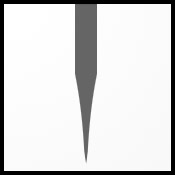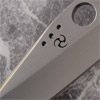Hollow Grind - Blade Geometry
Hollow Grind Info

Description
Imagine a curved grinding wheel removing steel from a peice of bar stock to form a blade grind. Naturally, the curved shape of the grinding wheel would cause the primary bevel to be curved as it removes material, creating a somewhat hollowed-out appearance. This is what we call a hollow grind.
The hollow grind is probably the most common type of blade grind on the market. Not only is it easy for production knife companies to produce, but it offers a thin cutting edge, at the sacrifice of some edge depth. Since the blade gets thicker very quickly as you near the edge of the grind, it tends to lend itself to shallow rather than deep cuts. The hollow grind is ideal for cutting soft tissue, which is why it is found on skinners and scapels.
Hollow grinds always have a secondary bevel. Without a secondary bevel, the edge on a hollow grind blade would be extremely fragile.
Many custom knifemakers also favour a hollow grind, partially due to its ability to achieve a sharp edge. Sometimes the reason is the aesthetics that can be acheived with hollow grinding a blade, especially with a combination of grinds to create unique blade shapes such as the Nightmare Grind.


